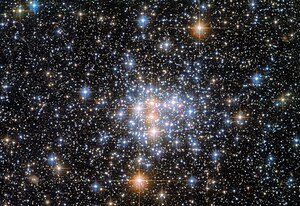NGC 376
(c) Credit: ESA/Hubble & NASA, A. Nota, G. De Marchi, CC BY 4.0 | |
| Aufnahme mithilfe des Hubble-Weltraumteleskops | |
| AladinLite | |
| Sternbild | Tukan |
| Position Äquinoktium: J2000.0 | |
|---|---|
| Rektaszension | 01h 03m 53,44s [1] |
| Deklination | −72° 49′ 34,2″ [1] |
| Erscheinungsbild | |
| Helligkeit (visuell) | 10,90 mag [1] |
| Helligkeit (B-Band) | 11,16 mag [1] |
| Winkelausdehnung | 1' [2] |
| Rötung (Farbexzess E(B-V)) | 0,037 [3] |
| Physikalische Daten | |
| Zugehörigkeit | KMW [2] |
| Geschichte | |
| Entdeckt von | James Dunlop |
| Entdeckungszeit | 2. September 1826 |
| Katalogbezeichnungen | |
| NGC 376 • Dun 36 • ESO 29-SC29 • GC 200 • h 2378 • Lindsay 72 • Kron 49 | |
NGC 376 ist ein offener Sternhaufen im Sternbild Tukan in der Kleinen Magellanschen Wolke.
NGC 376 wurde am 2. September 1826 von dem schottischen Astronomen James Dunlop entdeckt.[4]
Weblinks
Einzelnachweise
Auf dieser Seite verwendete Medien
(c) Credit: ESA/Hubble & NASA, A. Nota, G. De Marchi, CC BY 4.0
Head in the Clouds
A small portion of the Small Magellanic Cloud (SMC) is pictured in this image from the NASA/ESA Hubble Space Telescope. The SMC is a dwarf galaxy and one of the Milky Way’s nearest neighbours, lying only about 200 000 light-years from Earth. It makes a pair with the Large Magellanic Cloud, and both objects can be seen from the southern hemisphere, as well as from some northern latitudes.
The Small Magellanic Cloud contains hundreds of millions of stars, but this image focuses on just a small fraction of them. These stars comprise the open cluster NGC 376, which has a total mass only about 3400 times that of the Sun. Open clusters, as the name suggests, are loosely bound and sparsely populated. This distinguishes open clusters from globular clusters, which are often so thronged with stars that they have a continuous blur of starlight at their centres. In the case of NGC 376, individual stars can be picked out clearly even in the most densely populated parts of this image.
The data in this image come from two different astronomical investigations which relied on two of Hubble’s instruments: the Wide Field Camera 3 (WFC3) and the Advanced Camera for Surveys (ACS). The first investigation used the ACS to explore a handful of star clusters in the Small Magellanic Cloud and help astronomers explore topics including the abundance of low- and high-mass stars in different environments. The second investigation used both the WFC3 and ACS, and aimed to answer fundamental questions about the lives of stars and help astronomers understand precisely where, when, why and how stars form.
[Image description: A large number of bright stars, each with a cross-shape extending from its centre. In the centre there is a dense collection of foreground stars. Five are orange and the rest are blue. The black background is filled with small stars — most of them, however, larger than a single point.]
Credit:
ESA/Hubble & NASA, A. Nota, G. De Marchi
Coordinates Position (RA): 1 3 53.64 Position (Dec): -72° 49' 27.77" Field of view: 2.24 x 1.54 arcminutes Orientation: North is 26.7° left of vertical
Colours & filters Band Wavelength Telescope Optical V 555 nm Hubble Space Telescope ACS Optical V 555 nm Hubble Space Telescope ACS Optical I 814 nm Hubble Space Telescope ACS Optical I 814 nm Hubble Space Telescope ACS Optical N II 658 nm Hubble Space Telescope WFC3.

